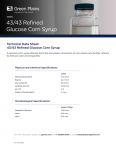Own brand confectionery grows across European markets
grow strongly, according the latest statistics by Neilsen for the
Private Label Market Association.
Private label brands - also known as 'store brand' and 'own label' - are exclusive to a chain of stores (although they can be carried across various stores owned by the same corporation). For stores, they are a useful way of spreading their brand into households, as well as attracting consumers to stores with the promise of lower-price goods. Results indicate that the retailer brand market grew strongly across 15 of the 18 countries studied by Neilsen. Western European countries had significant growth, despite strong competition from the brands, however, the biggest results were in Central and Eastern Europe. The results highlighted that private labels accounted for more than half of all frozen food and paper products in much of Western Europe, with equally significant growth across many industries. Total private label market share was highest in Switzerland, where 53 per cent of products sold were retailer brands, valued at 46 per cent of the total market. Private label market share was next strongest in the UK, with 43.3 per cent, worth 39.6 per cent of the market, followed by Belgium's total private label market share of 42.1 per cent and Germany's at 38.9 per cent. Retailer brand confectionery has continued to grow across Europe, in both Eastern and Western countries. In the UK, nearly a quarter of confectionery products sold were retailer brands in 2006, up 1.2 per cent from 2005. The greatest growth in the confectionery market was in treated nuts, which grew by 4.1 per cent, however plain recipe chocolate bars lost 20.8 per cent of the retailer brand market. Coated fruit confectionery was the third top gainer of market share points in 2006, rising 18.7 points. In France, however, the retailer brands of confectionery held 19.1 per cent of the confectionery market, which was 1.4 per cent up on 2005. Lollipops were in the top ten products for market share gain in the entire of France in 2006, gaining 6.2 per cent. In Germany, retailer brand confectionery held 35.8 per cent of the market, with the biggest growth seen in Halloween sweets, raising 17.8 per cent on 2005 to 52.4 per cent of the market. This was the second top product to grow in volume in Germany after tooth whitener, however, gained the greatest in value by 44.3 per cent to holding 72.1 per cent of the Halloween sweets market in 2006. In Spain, retailer brands hold 20.8 per cent of the confectionery market, where the biggest gains were seen in eucalyptus sweets and chocolate bars. "For the past few years, the A-brands launched a strong counter attack to stop the expansion made by retailer and wholesaler brands," said Brian Sharoff, president of PLMA. "This effort had an impact, causing private label's market share in the UK to decline. The latest Neilsen data shows that this trend has been reversed." However, the Neilsen data has revealed the biggest market share gains were in Central and Eastern Europe, with large share increases in Czech Republic, Hungary, Poland and Slovakia. Many confectionery companies have recently revealed their strategies to break into the eastern European markets, notably Cadbury's recent acquisition in Romania, Cemoi in Poland and Leaf International to Slovakia. In Hungary, 23 per cent of the confectionery market was private label brands, with candies gaining 8.7 percent between 2005 and 2006 to 31.3 per cent, and lollipops gaining 8.4 per cent to 14.8 per cent of the market. In Poland, retailer brand chocolate spread held 42.9 per cent of the market, and chocolate tablets held 24.1 per cent of the market, up 6.8 per cent from 2005. The biggest growth in Poland was in candies, which went up 7.5 per cent from 2005 to 19 per cent of the market. In the Czech Republic, the retailer brand confectionery went up from 5.7 per cent to 18.6 per cent of the market between 2005 and 2006, where the biggest growth was in candies, gaining 18.9 per cent of the market to 26.3 per cent within the year.










